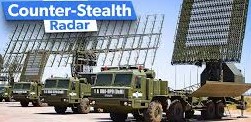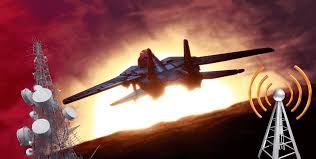My article was published in the “Life of Soldier” Journal Jun 25 Issue.
Stealth technology, a marvel of engineering designed to render aircraft, ships, and other military assets nearly invisible to radar, infrared, and other detection systems, has been a cornerstone of modern warfare since the late 20th century. Stealth platforms have provided significant tactical advantages by reducing radar cross-sections (RCS), absorbing radar waves, and minimising heat signatures. However, as stealth technology has proliferated, so too have counter-stealth technologies aimed at detecting, tracking, and neutralising these elusive targets. The race to detect the undetectable has intensified as stealth platforms proliferate in modern arsenals. Counter-stealth technologies—once niche and experimental—are now at the forefront of 21st-century defence strategy.
Principles of Stealth Technology. To understand counter-stealth technologies, it’s essential to grasp how stealth works. Counter-stealth technologies aim to exploit weaknesses in these principles, leveraging advanced sensors, signal processing, and innovative detection methods to uncover hidden assets. Stealth platforms rely on several key principles:-
-
- Radar Cross-Section Reduction. Stealth vehicles are designed with smooth, angular shapes to deflect radar waves from the source, minimising the energy returned to the radar receiver. Materials like radar-absorbent coatings further reduce reflectivity.
-
- Infrared Signature Suppression. Engines and exhaust systems are engineered to minimise heat emissions, making it harder for infrared sensors to detect the platform.
-
- Electronic Emission Control. Stealth systems limit or disguise electromagnetic emissions, such as radio or radar signals, to avoid detection by electronic support measures (ESM).
-
- Acoustic and Visual Camouflage. Submarines and some aircraft reduce noise and visual signatures to evade sonar and optical detection.
Evolution of Counter-Stealth Technologies. The quest to counter stealth began shortly after the introduction of stealth aircraft like the F-117 Nighthawk in the 1980s. Early efforts focused on improving existing radar systems and exploring alternative detection methods. For example, during the 1999 Kosovo War, Serbian forces reportedly used outdated but modified low-frequency radars to detect and shoot down an F-117, highlighting vulnerabilities in stealth designs optimised against high-frequency X-band radars used in most modern systems. Low-frequency radars became an early counter-stealth tool operating in the VHF and UHF bands. Though less precise, these radars can detect stealth aircraft because their longer wavelengths are less affected by radar-absorbent materials and angular designs. However, their large size and limited resolution initially restricted their battlefield utility.
Modern Counter-Stealth Advancements.
Counter-stealth technologies have become more sophisticated in the 21st century, driven by advancements in computing, sensor fusion, and materials science.
Advanced Radar Systems.
-
- Low-Frequency and Bistatic Radars. Modern low-frequency radars, such as Russia’s Nebo-M and China’s JY-26, combine improved signal processing with mobility, overcoming earlier limitations. Bistatic and multistatic radar systems, which separate the transmitter and receiver, further complicate stealth designs by detecting scattered radar waves that stealth platforms cannot entirely suppress.
-
- Over-the-Horizon (OTH) Radars. OTH radars bounce signals off the ionosphere to detect targets thousands of kilometers away. Systems like Australia’s Jindalee Operational Radar Network can track stealth aircraft over vast distances, though their resolution remains coarse.
-
- Passive Radar Systems. These systems detect stealth platforms by analysing ambient electromagnetic signals from FM radio, TV broadcasts, or cellular networks. Because stealth platforms cannot eliminate all reflections, passive radars can exploit these signals to identify anomalies. The Czech Republic’s Vera-NG is a notable example.
Infrared and Electro-Optical Systems. Infrared search and track (IRST) systems have become a powerful counter-stealth tool. By detecting heat signatures from engines, exhausts, or even aerodynamic friction, IRST systems bypass radar stealth entirely. Modern IRST systems, like those on the Russian Su-57 or the Eurofighter Typhoon, use advanced focal plane arrays and image processing to distinguish stealth platforms from background noise. Electro-optical systems, combining high-resolution cameras with machine learning, can also identify visual anomalies, such as aircraft silhouettes against the sky.
Acoustic and Seismic Detection. Acoustic and seismic sensors offer detection capabilities for ground-based or naval stealth assets. Despite their stealth, submarines produce low-frequency noise that hydrophones and sonar arrays can detect. Similarly, seismic sensors can detect vibrations from stealth vehicles or aircraft, particularly during takeoff or landing. Signal processing advances have improved these systems’ sensitivity, enabling detection over greater distances.
Quantum and Photonic Technologies. Emerging quantum radar systems promise to revolutionise counter-stealth detection. Using entangled photons, quantum radars can detect objects with unprecedented sensitivity, even through radar-absorbent materials. China has claimed progress in this area, though practical deployment remains years away. Photonic radars, which use laser-based systems, also show potential for high-resolution detection of stealth platforms.
Sensor Fusion and Artificial Intelligence. Perhaps the most significant advancement in counter-stealth technology is integrating multiple sensor types through sensor fusion. By combining radar, IRST, acoustic, and passive systems data, militaries can create a comprehensive picture of the battlefield. The role of AI in counter-stealth technologies is crucial, as it enhances the detection process and aids in developing more sophisticated and adaptive stealth designs. Artificial intelligence (AI) enhances this process by analysing vast datasets in real time, identifying patterns, and filtering out noise. For example, AI can distinguish a stealth aircraft’s faint radar return from environmental clutter, improving detection accuracy.
Challenges in Counter-Stealth Development
Despite these advancements, counter-stealth technologies face significant challenges:-
-
- Signal-to-Noise Ratio. Stealth platforms are designed to produce minimal detectable signatures, making it difficult for sensors to distinguish them from background noise.
-
- Cost and Complexity. Advanced counter-stealth systems, such as quantum radars or multistatic arrays, are expensive and require significant infrastructure. Deploying and maintaining these systems can strain defence budgets.
-
- Adaptability of Stealth. As counter-stealth technologies evolve, so do stealth designs. Newer platforms, like the B-21 Raider, incorporate lessons from past vulnerabilities, making them harder to detect.
-
- Electronic Warfare. Stealth platforms often employ electronic countermeasures, such as jamming or decoys, to confuse or overwhelm counter-stealth systems.
Case Studies
Russia’s S-400 and S-500 Systems. Russia’s S-400 and S-500 air defence systems exemplify modern counter-stealth capabilities. These systems integrate low-frequency radars, IRST, and advanced signal processing to detect and track stealth aircraft. For instance, the S-400’s 91N6E radar operates across multiple frequency bands, making it effective against low-RCS targets. The S-500, with its reported ability to engage hypersonic and stealth targets, underscores Russia’s investment in counter-stealth technology.
China’s Anti-Stealth Efforts. China has prioritised counter-stealth development, deploying systems like the Type 055 destroyer’s integrated sensor suite and the Divine Eagle UAV, which uses low-frequency radar for long-range detection. China’s quantum radar and AI-driven sensor fusion advancements further position it as a leader in this field.
NATO’s Integrated Air Defence. NATO countries have focused on networked counter-stealth solutions. For example, the U.S.’s Aegis Combat System integrates radar, IRST, and passive sensors across ships and aircraft, creating a layered defence against stealth threats. Through projects like the Future Combat Air System (FCAS), European nations are developing AI-enhanced counter-stealth capabilities for next-generation warfare.
Future of Counter-Stealth Technologies
Looking ahead, counter-stealth technologies will likely focus on three key areas:-
Hyperspectral and Multispectral Sensing. Hyperspectral sensors can detect subtle signatures that stealth platforms cannot entirely suppress by analysing targets across a broader range of wavelengths. These systems, already used for satellite reconnaissance, could be adapted for real-time battlefield detection.
Distributed Sensor Networks. Future counter-stealth systems will rely on vast networks of small, low-cost sensors deployed across air, sea, and land. These networks, linked by AI, will create a resilient detection grid that stealth platforms find difficult to evade.
Directed Energy and Electronic Warfare. Counter-stealth technologies may integrate directed energy weapons, such as lasers or microwaves, to neutralise stealth platforms as detection improves. Advanced electronic warfare systems could also disrupt stealth platforms’ onboard systems, rendering them vulnerable.
Strategic Implications
The development of counter-stealth technologies raises profound questions about the future of warfare. On one hand, these technologies enhance defensive capabilities, potentially deterring aggression by neutralising the advantages of stealth. On the other hand, they risk escalating arms races, as nations invest in ever-more advanced stealth and counter-stealth systems.
Conclusion
Counter-stealth technologies represent a dynamic and rapidly evolving field, driven by the need to counter one of the most transformative innovations in modern warfare. From low-frequency radars to quantum sensors, these technologies leverage cutting-edge science to pierce the veil of invisibility. However, as the technological race between stealth and counter-stealth intensifies, militaries must balance innovation with strategic stability. The future of warfare will likely be defined not by the dominance of one technology but by the interplay of offence and defence in an increasingly complex battlespace.
Please Add Value to the write-up with your views on the subject.
For regular updates, please register your email here:-
References and credits
To all the online sites and channels.
Pics Courtesy: Internet
Disclaimer:
Information and data included in the blog are for educational & non-commercial purposes only and have been carefully adapted, excerpted, or edited from reliable and accurate sources. All copyrighted material belongs to respective owners and is provided only for wider dissemination.
References:-
- Sweetman, B. (2013). The Stealth Fighter: How the F-117 Changed Warfare. Zenith Press.
- Roblin, S. (2019). “How Russia’s S-400 and S-500 Missile Systems Plan to Take on Stealth Aircraft.” The National Interest.
- Majumdar, D. (2016). “China’s Quantum Radar: The Next Big Thing in Stealth Detection?” The Diplomat.
- Easton, I., & Hsiao, L. C. (2017). The Chinese People’s Liberation Army’s Anti-Stealth Strategy. Jamestown Foundation.
- Gilli, A., & Gilli, M. (2019). “The Diffusion of Stealth Technology and the Challenges for Air Defence.” Journal of Strategic Studies, 42(3-4), 451-479.
- Hammes, T. X. (2020). Technological Change and the Future of Warfare. Brookings Institution Press.
- Rogoway, T. (2021). “Passive Radar Systems Are Becoming a Bigger Threat to Stealth Aircraft.” The Drive.
- Kopp, C. (2010). “Counter-Stealth Radar Technologies: An Analysis of Low Frequency and Bistatic Systems.” Air Power Australia.
- Perrett, B. (2018). “Australia’s Jindalee Over-the-Horizon Radar: A Strategic Asset for Stealth Detection.” Aviation Week & Space Technology.
- Fulghum, D. A. (2014). “Infrared Search and Track Systems: The Next Generation of Counter-Stealth.” Aerospace America.
- Singer, P. W., & Cole, A. (2022). Ghost Fleet: A Novel of the Next World War. Houghton Mifflin Harcourt.
- Zikidis, K. C., Skondras, A., & Tokas, C. (2014). “Low Observable Principles, Stealth Aircraft and Anti-Stealth Technologies.” Journal of Computations & Modelling, 4(1), 129-165.
- U.S. Department of Defence. (2020). Electromagnetic Spectrum Superiority Strategy.
- Wang, B. (2023). “Quantum Sensing and Its Military Applications.” NextBigFuture.
- NATO Science and Technology Organisation. (2021). Future Air and Space Capabilities: Countering Low Observable Technologies.


